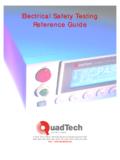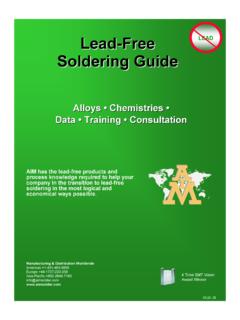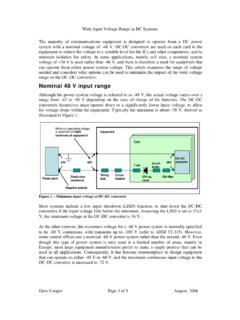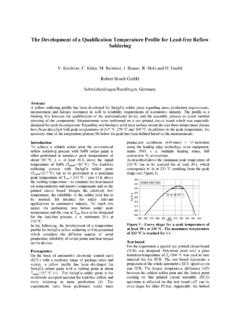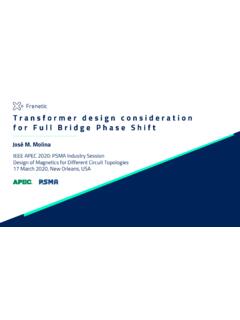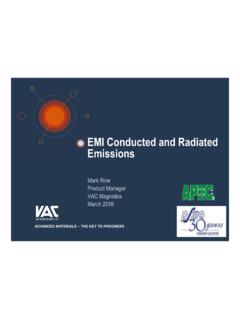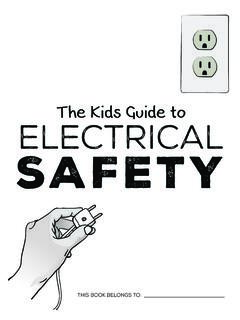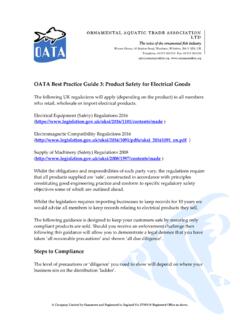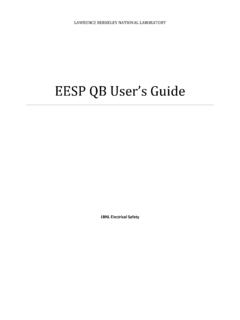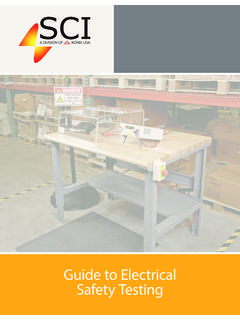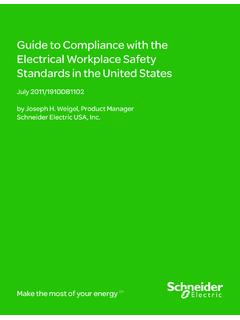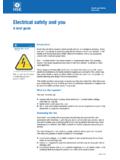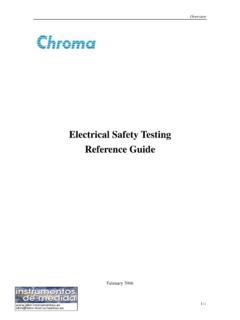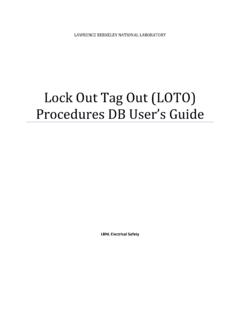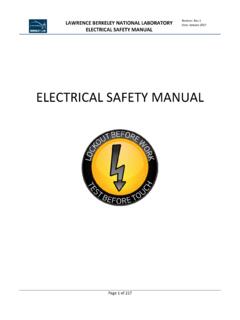Transcription of Electrical Safety Testing Reference Guide - psma.com
1 5 Clock Tower Place, 210 East, Maynard, Massachusetts 01754 TELE: (800) 253-1230, FAX: (978) 461-4295, INTL: (978) 461-2100http:// Safety TestingElectrical Safety TestingReference GuideReference GuideISO 9001 Certified23 The material in this Guide is for informational purposes only and is subjectto change without notice. QuadTech assumes no responsibility for anyerror or for consequential damages that may result from the misinterpre-tation of any content in this the Electrical product business, product Safety compliance is an impor-tant issue for several reasons. Manufacturers and distributors want to sell safe products . Consumers want to buy products with the assurance thatthey won t be exposed to hazards. Product quality, reliability, user safetyand company liability issues are real consequences of doing of your specific interest in Safety Testing , it is important for youto have a general understanding of product Safety requirements and howthey affect your device.
2 Needed as well is an overall view of the regulato-ry compliance world and the specific steps in the process that may have adirect impact on your daily intent of this Reference Guide is to explain the need for and the basisof Electrical Safety Testing (EST). This Guide provides a general overviewof the regulatory framework and approval process and explores the spe-cific manufacturing responsibilities and test procedures associated withelectrical Safety Clock Tower Place, 210 EastMaynard, Massachusetts 01754 Tele: (800) 253-1230 Fax: (978) 461-4295 Intl: (978) 461-2100 Web: 3 Overview 5 Product Safety 5 Electrical Shock 5 Worldwide Regulatory Compliance 6 United States 6 Canada 7 European Union 7 Typical Product Safety Standards 9 Standards in the News10 Compliance Tests 11 Production Line Testing 11 Dielectric Strength 12 Insulation Resistance 12 Leakage Current Tests 12 Ground Continuity 13 Ground Bond 13 Product Safety Tests 14 Dielectric Strength Tests 14AC or DC 14AC Hipot Tests15DC Hipot Tests15 Arcing 16 Line Regulation 17 Load Regulation 17 Ramping 18 Min/Max Current Detection 18 Ground Continuity Test 18 Polarization Test 19 Ground Bond Test 19 Insulation Resistance Test 20 Measurement Procedure 21 Dielectric Absorption 21 Charging Current 21 Leakage Current 21 Leakage Current Test 22 What is a Safe Level of Leakage?
3 23 Class I 23 Class II 23 Measurement of Leakage Current23 Operator Safety 26 Tester Environment 26 Operator Training 28 Testing Guidelines/Procedures 28 Test Equipment29 Choosing the Right Tester 29 Recommended Tester Features 30 General Tester Features 30 Production Tester Features 31 Accessory Equipment 33 Tester Calibration 33 NIST Standards 33120 Kohm Leakage Impedance 33 Tester Applications 34 Appliance Testing 34 Motor Testing 34 Transformer Testing 35 Electrical Component Testing 36 Examples of High Performance Testers 37 Sentry Series Testers 37S 10/15 AC Hipot Tester 37S 20/25 AC/DC Hipot Tester 37S 30/35 AC/DC/IR Hipot Tester 37S50 Ground Bond Tester37 Guardian Series Testers 38 Common Features 38 Guardian 1000 SeriesG 1010 AC Hipot Tester 38G 1030 AC/DC/IR Hipot Tester 38G 1030S AC/DC/IR/SC Hipot Tester 38 Guardian 2000 SeriesG 2510 AC Hipot Tester 38G 2520 AC/DC Hipot Tester 38G 2530 AC/DC/IR Hipot Tester 38 Guardian 6000 SeriesG 6000 Electrical Safety Analyzer39G 6100 Production Safety Analyzer 39G 6200 Production Safety Analyzer 39 Guardian Specialty SeriesG 500VA AC/DC/IR Hipot Tester40G 10kV AC Hipot Tester40G 12kV DC/IR Hipot Tester40 Dedicated Function Test Instruments 41 Milliohmmeters41 Megohmmeters41 Digibridge Component Testers41 Precision LCR Meters41 Appendix A 43 Nationally Recognized Testing Laboratories (NRTLs) and Standards Organizations44 Product Safety Standards 45 Typical Test Values: Product Safety Tests47 Application Note Directory 49 Glossary53 Contents5 Product SafetyMaking a product safe requires an under-standing of the hazards that exist in eachelectrical product.
4 Certain potential hazards areinherent in all Electrical products because of themanner in which they are powered and howthey perform their intended functions. Eventhough a product requires an Electrical powersource and uses Electrical or electronic compo-nents, it should not present an Electrical shockhazard to the user. Four fundamental hazards must be evaluatedas part of any product Safety evaluation: Electrical shock Mechanical/physical injury Low voltage/high energy FireSpecifications that address these hazards arecontained in every product Safety additional Safety requirements arealso included in most Safety standards, thesefour hazards are the foundation upon which allsafety standards are based. This Guide is onlyconcerned with Electrical Safety Testing meth-ods. It focuses only on the tests and equipmentneeded to minimize Electrical shock and doesnot discuss mechanical/physical injury and firehazards.
5 Electrical ShockElectrical shock and its effects can be causedand influenced by several factors. The primaryeffect is the result of Electrical current passingthrough the human body. Severity of the injuryto the human body is directly affected by suchvariables as: the nature of the Electrical voltage(AC vs. DC); the pathway through the humanbody; conductivity of the contact (wet or dry);the size and shape of the individual , the person s impedance), duration of thecontact, and the size of the contact area. Allthese affect the magnitude of current that flowsthrough the person s :Picture yourself in the bathroom with one handin a sink full of water. As you grab for a towelbehind you, the hair dryer (which is plugged in)falls into the sink. Your other hand contacts thegrounded cold water faucet. You have placedyourself in the path of current flowing from theelectrical outlet in which the hair dryer isplugged.
6 The pathway, which is directly throughyour chest cavity, is likely to cause ventricularfibrillation. (Fibrillation occurs when the electri-cal pulses controlling your heart rate go into anuncontrollable pulsation, which prevents yourheart from pumping properly, causing bloodpressure to drop, eventually shutting down allbodily functions.)It is difficult to set standards that protect usersfrom all possible fault conditions, but manyrequirements have been established to providefundamental levels of user Safety . The previousexample is the reason GFCI (ground fault cur-rent interrupters) are required by the NationalElectrical Code in wet locations. Such devicesautomatically interrupt power when a groundcurrent larger than 5 mA exists for more than afew milliseconds. These devices have savedcountless people from being electrocuted intheir own frequency in Hertz (Hz); , cycles per sec-ond, of the Electrical source is also a determin-ing factor in the subsequent effect and/or reac-tion of the human body when subjected to elec-trical current flow.
7 Studies have shown that lowfrequency voltages, such as AC power line volt-age (50/60Hz) which is commonly found in thehousehold or workplace, have a more immedi-ate and damaging effect than DC voltage whencontact with the human body occurs. Therefore,it is important that Electrical products and appli-ances be designed to protect the user from con-tact with AC line/primary voltage. Overview6 Most Safety standards address this issue byincorporating requirements that mandateappropriate product enclosures: connectorsthat do not allow direct user access, gooddielectric or insulating barriers, as well as verylow leakage current. Not all voltage potentials,however, are considered hazardous. Some areconsidered safe for user contact because of thelow levels at which they operate. Since thestandards are very specific about these limits,manufacturers must be careful to test theirproducts against the right product standard tobe sure that the products are shock hazards can be prevented bythe following types of tests: 1.
8 Dielectric Withstand (Hipot) Tests2. Insulation Resistance Tests3. Leakage Current Tests4. Ground Continuity TestsA hipot testmeasures the ability of a product towithstand a high voltage applied between thecircuits of a product and ground. An insulation resistance testmeasures thequality of the Electrical insulation used in aproduct. A leakage current testchecks that the currentthat flows between AC source and ground doesnot exceed a safe limit. A ground continuity testchecks that a pathexists between all exposed conductive metalsurfaces and the power system of these tests is described in detail later inthis document. Worldwide Regulatory Compliance In the field of product Safety and product safetystandards, significant change has taken placein the last ten years. Emphasis has been placedon the worldwide harmonization of productsafety standards with the hope of establishingtruly uniform global specifications.
9 Althoughmore progress needs to be made, results todate have been encouraging. Standards todayare more closely coordinated than ever need to know and understandthe Safety standards that apply to their particu-lar products. It is equally important for them tohave a full grasp of the whole field of productsafety regulation. In an attempt to provide a basic explanation ofthe regulatory process, how it works, and whyyou must comply, let s look at three of the majormarketplaces, the United States, Canada, andthe European Union (EU).United States In the , regulatory requirements and feder-al laws are found in the Code of FederalRegulations. In this Code (CFR21-1910,Subpart S), you will find regulations for productsafety approvals of Electrical devices. Themandatory federal requirements specify that allelectrical appliances and devices be listed bya Nationally Recognized Testing Laboratory(NRTL) for the purpose in which they will beused.
10 The term listed means controlled, mon-itored, and otherwise placed under formal sur-veillance by the approval agency or Testing lab-oratory. The term NRTL now applies to manylaboratories operating under OSHA(Occupational Safety and HealthAdministration) accreditation for the purpose ofcarrying out product Safety approvals accordingto accepted standards. For a current list ofleading NRTLs, refer to Appendix listed product is commonly identified by thetesting laboratory s listing mark (UL, ETL, MET,FM, etc.) conspicuously attached to the prod-uct. This listing mark indicates that the devicemanufacturer has submitted a sample to thelaboratory for product Safety test and evaluationin accordance with the relevant product safetystandard. Once the NRTL finds the product fullycomplies with the standard, it grants the manu-facturer permission to affix the agency listinglabel to the products.
